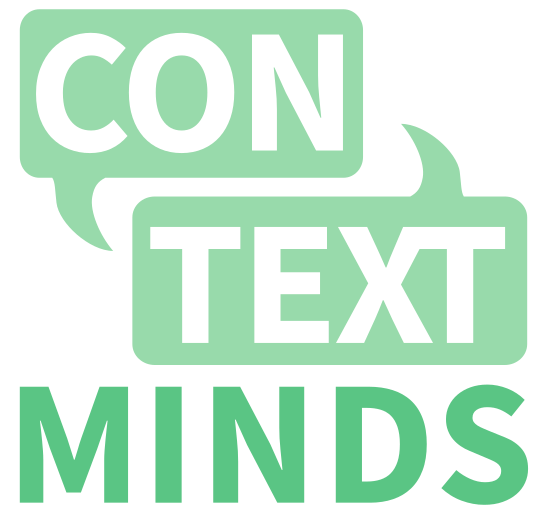Transform Your Writing: Expert Tips for Crafting Trusted, Research-Backed Content
Creating trustworthy content is challenging. You know it, and so does your audience. With the abundance of information available, it’s difficult to stand out as a reliable source. People are constantly questioning the validity of what they read and whether they can trust the source. Is this true? Can I trust this source? These are the hurdles you face as a content creator every day.
So, your mission is to provide content that not only grabs attention but also holds up under scrutiny. This means backing up your words with solid research and facts to ensure every claim you make is trustworthy.
In this blog, we'll explore effective ways to boost the trustworthiness of your content. By conducting extensive research and presenting information that not only engages but also earns the trust of your audience, you can create content that is not only read but also respected and believed. . It will help you in creating content that's not just read but also respected and believed.
Before we dive into the strategies for enhancing trustworthiness in your content, let's take a moment to understand why it's so vital.
Why Trustworthiness in Content is Crucial
Trustworthiness in content is the backbone of your relationship with your audience. It makes your readers come back for more, believing in the value you offer. When your content consistently reflects accuracy and reliability, you're not just sharing information but building a foundation of credibility. This trust is crucial for several reasons:
1. Building Credibility with Your Audience: Your content is more than just words on a screen; it reflects your expertise and authority. When your audience discovers your content to be consistently accurate and well-researched, their trust in you grows. This trust transforms casual readers into loyal followers who consider you as a go-to source in your field. They're more likely to take your advice, try your recommendations, and trust your insights. In the long run, this credibility sets you apart in a crowded digital landscape.
2. Impact on Brand Reputation: Trustworthy content does wonders for your brand's image. Being known for reliable content can help your brand stand out in an age where brands are often scrutinized for authenticity. It demonstrates that you prioritize truth and value the experience of your audience. This reputation for reliability attracts new customers and retains existing ones, as they associate your brand with integrity and quality.
3. Fostering Reader Engagement and Loyalty: Readers engage more with content they trust. When they believe in the accuracy of the information you provide , they're more likely to interact with it — be it through comments, shares, or discussions. This engagement is a key driver of content virality and reach. Moreover, trusted content fosters reader loyalty. Loyal readers don't just consume your content; they advocate for it, recommending it to others and creating a community around your brand.
4. Avoiding the Consequences of Misinformation: The flip side of trustworthiness is the risk of spreading unverified or false information. The internet never forgets, and a tarnished reputation for inaccuracy can be hard to shake off. Misinformation can lead to a loss of reader trust, diminished brand reputation, and, in some cases, legal ramifications. Avoiding these pitfalls is crucial, as rebuilding a tarnished image is often more challenging than maintaining a reputation for trustworthiness.
Having understood the importance of trust in your content, let's look at effective ways to embed this trustworthiness into your work.
Practical Ways to Ensure Trustworthiness in Your Content
In this part of our journey, we'll explore actionable strategies to make your content engaging and trustworthy. Let's dive into specific practices that will elevate your content's reliability.
1. In-Depth Research and Fact-Checking:
The bedrock of credible content lies in its accuracy, which can be achieved through detailed research and meticulous fact-checking. This process is vital as it ensures that every piece of information you present is correct and up to date. Inaccuracies can quickly erode your audience's trust, while well-researched content can establish you as a reliable and authoritative source.
However, ensuring that your research is comprehensive involves more than just a cursory glance at available information. Here's how you can deepen your research process:
Diverse Source Exploration: Begin by expanding the scope of your sources. Don't limit yourself to the top search engine results or familiar websites. Broaden your horizon to include academic journals, industry-specific studies, government publications, and interviews with subject matter experts. These sources often provide richer, more nuanced information that isn't readily available in mainstream articles.
With ContextMinds, expanding your research to include diverse sources becomes significantly more manageable. This tool can serve as your central hub for accessing various information channels, which are crucial for crafting well-rounded and trustworthy content.
It pulls together a wealth of resources, from an internal knowledge base with community insights and Wikipedia facts to a selection of pertinent articles sourced from Microsoft Bing.
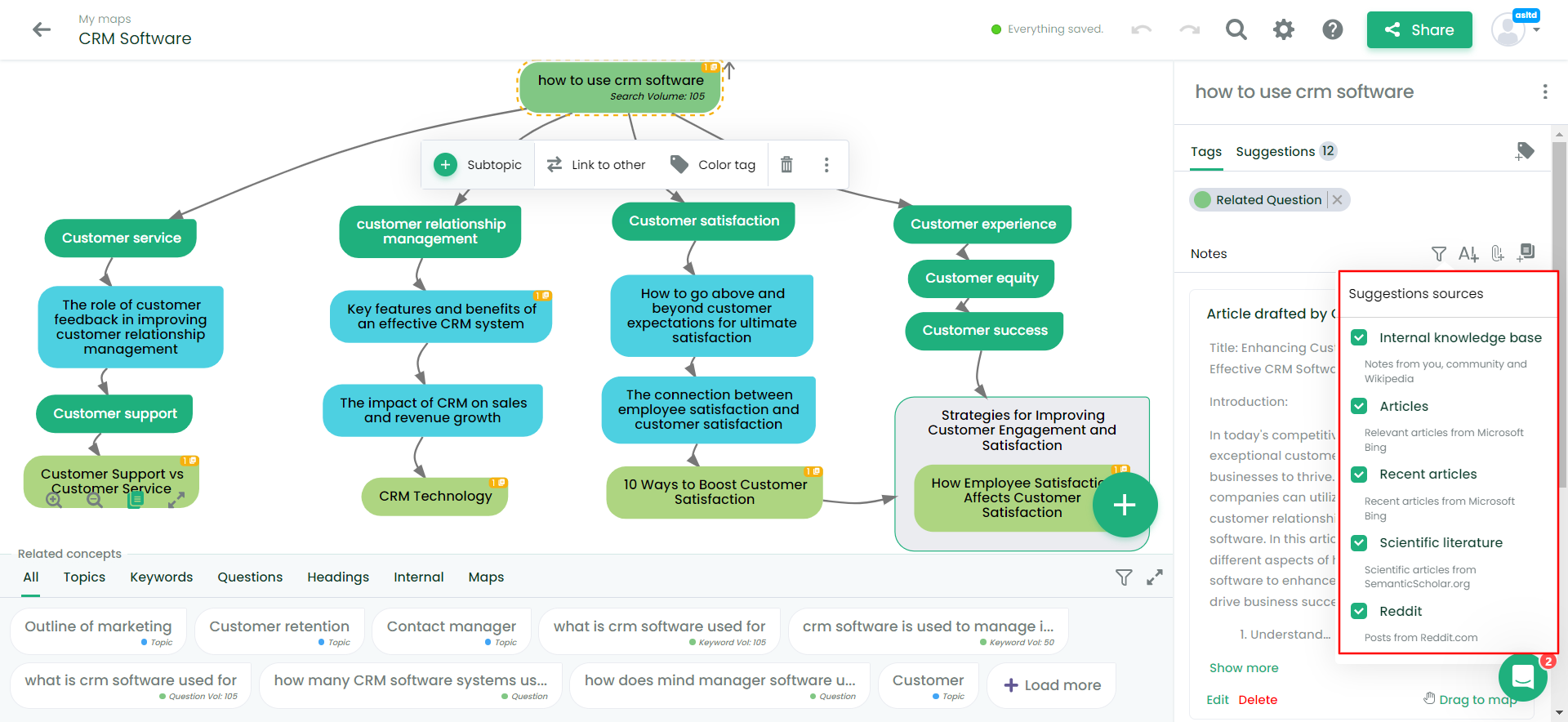
The platform doesn't stop at general articles; it connects you to the latest publications and scientific literature from SemanticScholar.org for those deep dives into your subject. It even provides perspectives from social media platforms like Reddit are within reach, offering a pulse on current discussions and community sentiment.
ContextMinds equips you with a comprehensive, up-to-date collection of information, ensuring your content is grounded in varied and authoritative sources.
Cross-Referencing Information: Once you have gathered information from various sources, it's crucial to cross-check them. Look for consistency in data and viewpoints. If you find discrepancies, dig deeper to understand why they exist. This helps verify facts and gain a more comprehensive understanding of the subject.
Staying Current: In the fast-paced information age, data can become outdated quickly. Ensure that the statistics, studies, and references you use are current. This is especially important in fields like technology, science, and health, where new discoveries are constant.
Analyzing Source Credibility: Every source is not created equal. Evaluate the credibility of your sources by checking their authorship, publication date, and the reputation of the publishing platform. Trustworthy sources typically have a track record of reliability and are recognized in their respective fields.
Remember, the goal is to make your content so reliable that your readers not only consume it but also trust it as a reference. This level of trustworthiness sets you apart as a content creator and builds a lasting bond with your audience.
2. Utilizing Reputable Sources and References:
Trust is earned when your content is anchored in credibility. Using reputable sources and references is a non-negotiable part of this process. These credible sources lend authority to your content, showing your readers that you're not just sharing opinions but facts supported by respected institutions or experts.
When you support your arguments with information from well-respected entities, your readers are more inclined to trust what you've written and your broader intentions as a content provider.
Authoritative sources act as lighthouses guiding readers to safe and trustworthy information. They are the backbone of your content's credibility. When you cite a study from a recognized university, statistics from a government report, or quotes from industry experts, you give your audience a sense of security. They feel confident sharing your content, knowing it's backed by reliable entities.
But how do you go about selecting these reputable sources? Here's a step-by-step approach:
- Identify Authoritative Entities: Look for sources that are universally recognized for their reliability and expertise. These include academic journals, books published by subject matter experts, official reports by government agencies, and articles from reputable news organizations.
- Evaluate Source Legitimacy: Not all information is created equal, even from professional outlets. Assess the legitimacy of a source by considering factors like the author's credentials, the publication date, the presence of peer reviews, and the institution's reputation.
- Cite Transparently: When you reference a source, make sure to do so in a manner that allows your readers to find the original material. This transparency boosts your credibility and encourages readers to engage with the subject further.
Remember, every fact, quote, or piece of data should be traceable to a source your audience can verify if they choose to. This transparency and commitment to quality elevates your content and builds lasting trust with your readers.
3. Incorporating Expert Opinions and Case Studies:
Including the voices of experts and analyzing real-life case studies can significantly bolster the authority of your content. These elements prove that the concepts you're discussing have merit and are recognized by professionals.
Experts bring years of experience and deep knowledge that can validate your points and give your audience a reason to trust your content. When a recognized authority echoes your message, it adds a layer of credibility that is hard to dispute. Moreover, case studies provide tangible evidence of how theories apply in practical scenarios, offering your readers an informative and engaging narrative.
The following are a few ways you can successfully incorporate this into your content:
- Research Industry Experts: Seek out thought leaders, professionals with substantial experience, and academics specializing in your topic. Tools like LinkedIn, industry publications, and academic databases can help find these individuals.
- Utilize Case Studies: Select case studies that are relevant to your topic and provide a clear narrative about challenges and solutions. They should be recent enough to be applicable and from sources that your audience finds credible.
- Quote Accurately: When quoting experts or citing case studies, be meticulous about accuracy. Misquoting an expert or misrepresenting a case study's findings can damage credibility.
- Provide Context: Don't mention a quote or case study without explaining its relevance. Provide context that ties the expert opinion or case study back to your point.
- Cite Sources: Always provide citations and, if possible, links to the original source of the expert opinions and case studies. This allows your readers to verify the information and further explore the subject if if desired.
Incorporating expert opinions and case studies is not just about adding depth to your content; it's about providing your audience with a multi-dimensional view of the subject. This approach enriches your content with perspective and evidence, thereby increasing its value and trustworthiness.
4. Maintaining Relevance through Content Updates
Today, information can become obsolete almost overnight. Regular updates are essential to keep your content accurate and trustworthy. This practice is about showing your audience that you're committed to providing them with the latest and most relevant information.
Keeping content current is crucial for several reasons:
- It shows you're active in your field and aware of the latest developments.
- Updated content can help maintain your rankings, as search engines favor fresh, relevant content.
- And most importantly, it reinforces the trust your readers have in your platform as a source of up-to-date information.
Here's how you can ensure your content stays updated:
- Set a Review Schedule: Decide on a regular interval to review and update your content. This could be quarterly, bi-annually, or annually, depending on how rapidly your subject matter changes.
- Monitor Industry Trends: Keep an eye on the latest developments in your field. Follow relevant news outlets, subscribe to industry newsletters, and participate in professional networks to stay informed.
- Engage with Your Audience: Listen to your readers. They can be a valuable source of feedback on what content needs updating. They may highlight new perspectives or changes in the industry that you haven't considered.
- Implement Changes: When updating content, ensure your changes are substantial and meaningful. It's not enough to change dates and statistics; you should also adjust your narrative to reflect the latest trends and understandings.
ContextMinds can significantly streamline this updating process with its ongoing topic and keyword updates. Its dynamic platform can suggest trending questions in your area of interest.
As you navigate your content, ContextMinds can suggest relevant updates and new angles on your topic, assisting you in maintaining the cutting edge quality of your content.
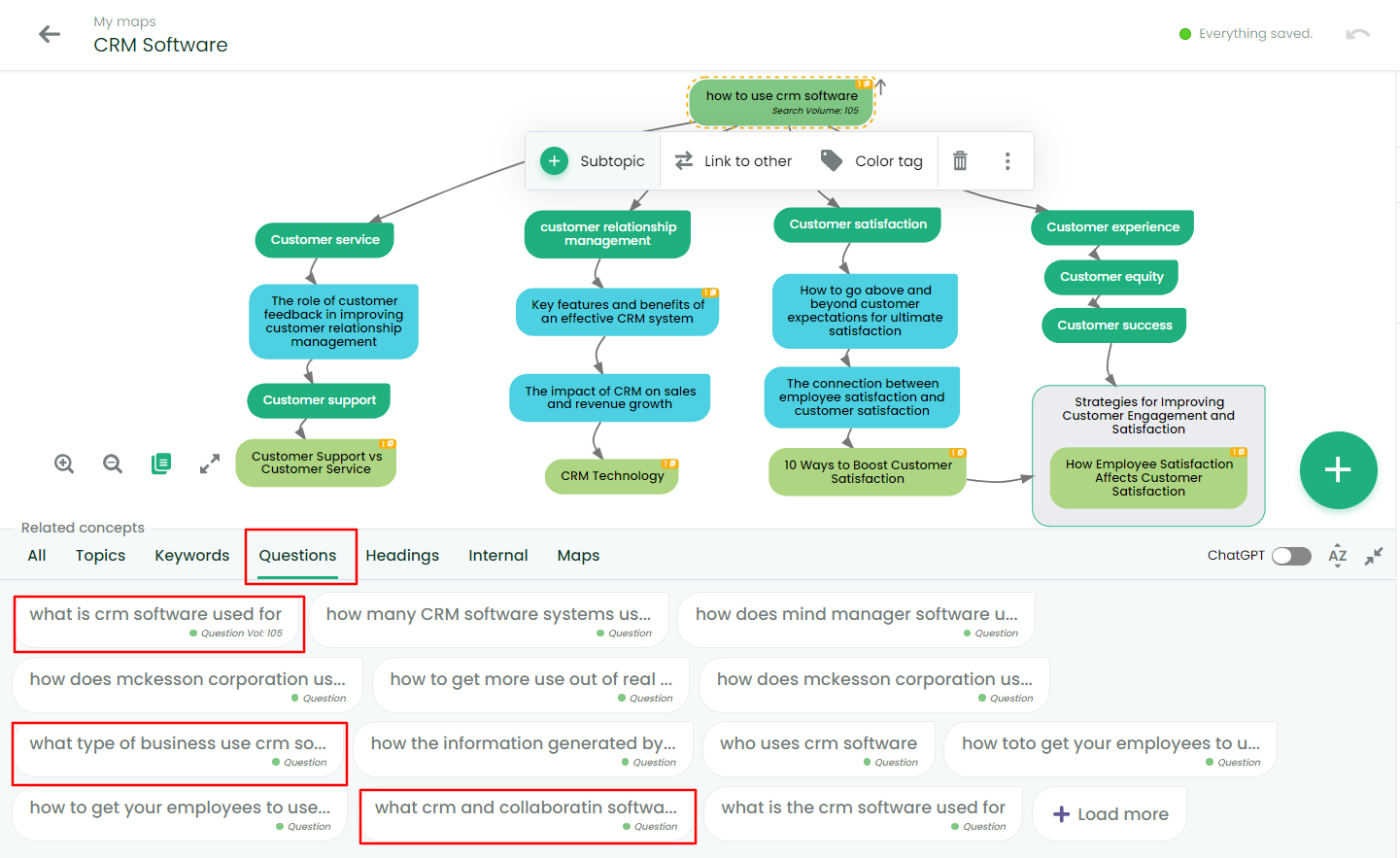
By using ContextMinds, you can seamlessly integrate these updates into your content. The tool's ability to analyze and suggest related topics and keywords means you can easily identify areas of your content that may need a refresh.
Also, it can aid in identifying which parts of your content may require updates with its visual content map feature, saving you the hassle of navigating through each piece manually. By using ContextMinds, you ensure that your content is not just a static piece of writing but a living document that evolves and grows with the latest developments in your field.
5. Building Trust Through Transparency and Honesty
Maintaining transparency and acknowledging uncertainties are acts of integrity that contribute to the overall trustworthiness of your content. By embracing honesty in your content presentation, you provide valuable information and reinforce the credibility of your work and your reputation as a content creator.
Being upfront about your sources, the limitations of your data, and the potential biases in your research fosters an environment of honesty. It's about taking your readers on a journey through your content, showing them every turn and stop along the way.
The importance of this practice cannot be overstated. When you're transparent, you tell your audience, "I have nothing to hide." This can significantly strengthen their confidence in your content. Acknowledging uncertainties is equally important. It conveys that you understand the complexity of the subject and are not oversimplifying or ignoring contradictory information.
Here's how you can achieve this:
- Explain Your Methodology: If you conducted research or analysis, describe your process. Let your readers know how you gathered your data, which can help them understand and evaluate your conclusions.
- Be Upfront About Limitations: If there are any doubts about the information, be transparent about them. For example, if a study's sample size is small or if there's a margin of error, mention it.
- Admit When You Don't Know: If certain information isn't available or you're unsure about something, it's okay to admit it. This honesty can go a long way in building trust.
- Update to Correct Errors: If you discover that your content includes an error, correct it promptly and visibly. Letting your readers know about the correction reinforces your commitment to accuracy.
- Invite Feedback: Encourage your readers to share their insights and corrections. This improves your content, engages your audience, and includes them in the knowledge-building process.
By integrating these practices into your content strategy, you create a transparent relationship with your readers based on mutual respect and the shared goal of truth-seeking.
6. Visualizing Success with Strategic Content Mapping
Visual mind maps are not just tools for organization; they're the blueprints for your content strategy, laying out the complex web of topics, research, and ideas in a clear, digestible format. By visualizing your strategy, you can align your research efforts with your content goals, ensuring that each piece of content serves a purpose and connects to the larger narrative of your brand.
The process of creating a mind map is both intuitive and insightful. It starts with a central idea or theme and then branches into related subtopics, research findings, and questions. This visual layout helps you see the connections between different pieces of information, identify gaps in your research, and generate new ideas. Moreover, it serves as a roadmap for your content creation process, guiding you from conception to publication.
Here's how you can get started with your own mind map:
Identify Your Core Topic: Begin with the central subject of your content strategy and place it at the center of your mind map.
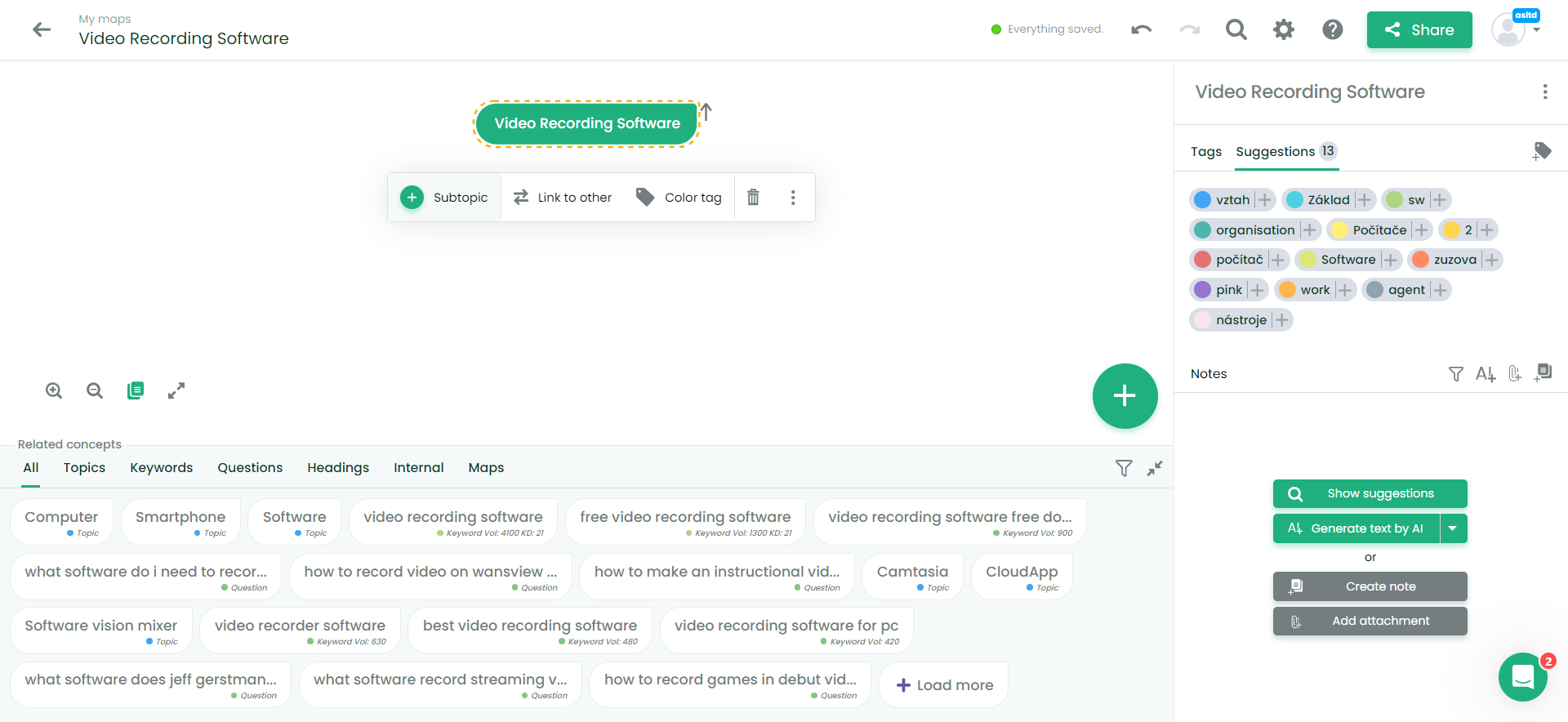
For example, if you are creating your content strategy focused on "Video Recording Software," put it at the center of your mind map. This is your primary focus.
Branch Out with Subtopics: Create branches for all the related subtopics, questions, and themes pertain to your central idea. Continuing our above example, from the core, extend branches to various related topics:
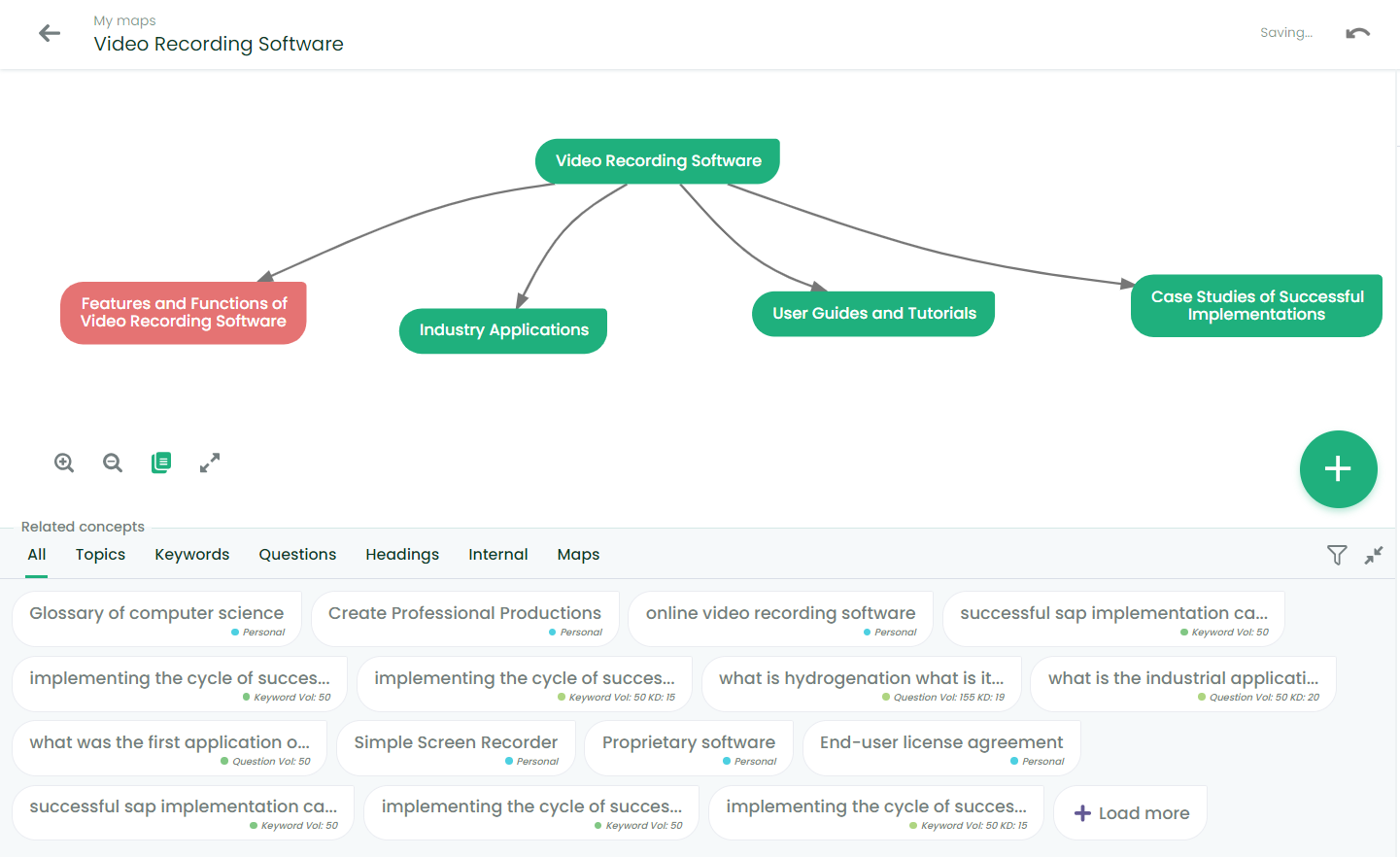
- "Features and Functions" could explore the software's key functionalities.
- "Industry Applications" might explore how different sectors can utilize the software.
- "User Guides and Tutorials" can provide practical usage tips.
- "Case Studies of Successful Implementations" can showcase real-world examples.
Incorporate Research and Data: Attach your research findings, data points, and sources to the relevant branches, creating a comprehensive repository of information. Further, in the video recording software example, attach specific details to each branch:
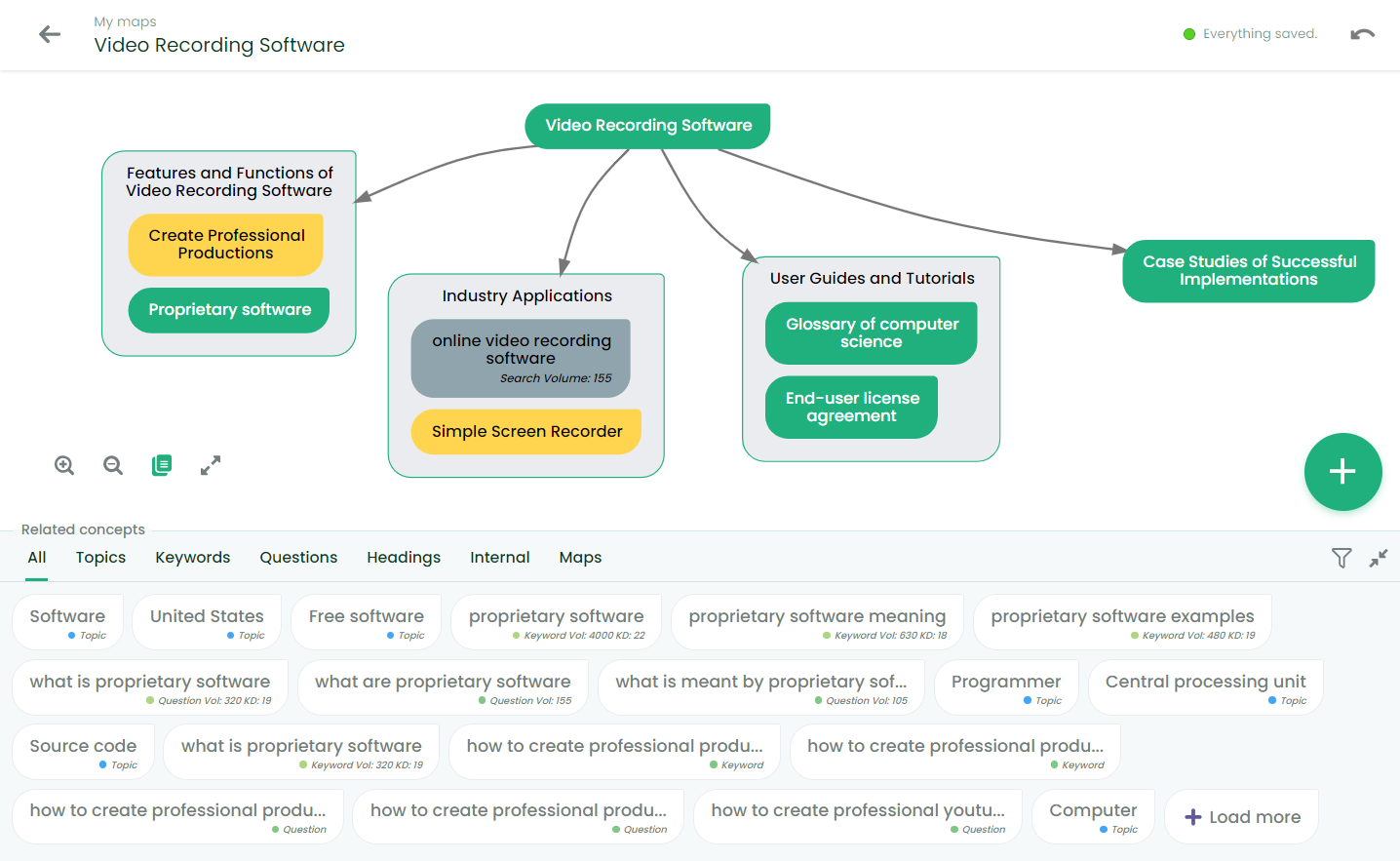
- Under "Features and Functions," list things like create professional productions, and proprietary software.
- For "Industry Applications," add information about the software categories, like online video recording software, and simple screen recorder
- In "User Guides and Tutorials," link to glossary or video walkthroughs.
- Attach actual case studies or client interviews to "Case Studies of Successful Implementations."
Plan Your Content: Determine how each branch can translate into a piece of content. This can include blog posts, videos, infographics, or social media updates. Lastly, in the video recording software example, translate the branches into a diverse content plan:
- For "Features and Benefits," write a detailed blog post outlining the software's unique selling points.
- Create an infographic for "Industry Applications," showing the software's versatility across various sectors.
- Develop a series of how-to videos for "User Guides and Tutorials," guiding users through the software's features.
- Write in-depth articles or produce video testimonials for "Case Studies of Successful Implementations," highlighting client experiences and outcomes.

No matter your field, creating a visual mind map is a step that shouldn't be skipped. It's a hands-on method that invites creativity and strategic thinking into your content planning process. Give it a try, and you might be surprised by how it can transform the way you think about and execute your content strategy.
Here, ContextMinds can enhance this process by providing a dynamic platform for strategic content planning and visualization. It can help you generate and organize topics and keywords, offering real-time updates and suggestions that can be directly integrated into your mind map.
This interactive approach makes the planning process more efficient and ensures that your content strategy is grounded in thorough research and adaptable to new insights and trends.
Conclusion
Throughout this guide, we've delved into practical strategies to ensure the trustworthiness of your content.
By now, you should have a clearer understanding of how to enrich your content with reliability and credibility. The next steps are all about implementation. Start by reviewing your existing content creation process. Identify areas where you can incorporate these strategies to enhance trustworthiness. Experiment with creating a mind map for your next content piece and see how this visual approach can transform your planning process.
To facilitate this process, consider adopting tools designed to enhance research and organization. ContextMinds offers an intuitive platform that can revolutionize how you plan, research, and execute your content strategy.

Useful links
Contact info
+420 607 881 942
info@contextminds.com
ContextMinds s.r.o
Blanická 922/25, Prague, Czechia
All Rights Reserved | EMC Engineering, s.r.o.
